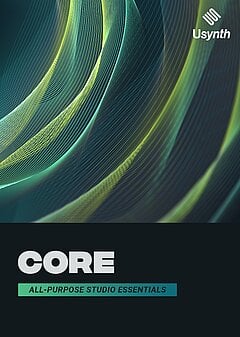How to Create Huge Bass Sounds
A step-by-step process from blank slate to finished bass sounds (and the must-have effects in your processing chain).
AUGUST 7TH, 2022
In this article, you’ll learn everything about the tools you need to start making huge bass sounds that cut through the mix and bring your entire song together :
Starting waveforms and shaping
The foundation of nearly all synth bass sounds (using either subtractive or additive methods) is one of several basic waveforms: sine, triangle, square / pulse, and sawtooth. Each has its own unique qualities, and you’ll need to become very familiar with them if you aren’t yet. You can frequency modulate, add to, distort and manipulate as you wish to build more complex sounds ... and if you enjoy creating more sound-design heavy genres like dubstep, it’s not a bad idea to learn the ins and outs of this process.
However, the simpler and more common approach is to use wavetable synthesizers that have tons of pre-existing wavetables you can morph through, containing a variety of distinct timbres. Massive was the industry standard option for this for quite some time, until Serum came onto the scene and offered a more customizable approach where users could even design their own waveforms. Plenty of other synths have come onto the scene that use the same essential methodologies, but at its core, wavetable synthesis is pretty straightforward.
Your job as a sound designer then becomes tweaking the wavetable with any options available in the UI (bend, sync, FM, etc.) and “macro” a combination of different parameters you can move with a single control. Done right, this will form the backbone of your bass sound and make the process of choosing effects much simpler, as the bulk of your work will already be done for you. However, it takes time to gain finesse in this area, which is why in Usynth CORE this macroing is all done in the background — you can get a complex, morphing sound with just a knob or two without any of the complicated setup! This makes the art of sound design much easier, as the busywork common to nearly all synths has been completely removed!
Adding motion via automation
Static bass sounds can work in a pinch, but to create excellent music it’s essential to give your bass plenty of motion. Automating multiple parameters at once via macros gives you plenty of control, but if you’re creating bass one shot or you want to test ideas faster, then sequencers, envelopes and LFOs provide an effective quick and dirty alternative that might be preferable. The important thing is to select parameters you want to modify, such as filters and wavetable positions, and program your synth such that they move in unison.
Once you have a good starting sound and you’re happy with the motion you can get by automating UI parameters, it’s time to dive into your DAW session and record. Start by adding a single, long bass note on a MIDI track, 4 beats or more. Open automation lanes for the macros you created (or one of the knobs below the Synthesizer section if you’re in CORE) and start drawing shapes across the length of the bass note. There’s no real science behind this — simply loop this region, draw in what you feel you need, and tweak until it has the motion you want. The result will typically be more complex and organic if you automate multiple macros at once in different shapes, so don’t limit yourself to just one!
Adding dirt with distortion
This is where the real fun begins! Once you have the bass’s motion down, you can be fairly heavy-handed with effects. The best area for this may very well be distortion given how much grit and life it can add in very little time. A few fantastic tools are Ohm Force’s Ohmicide and Predatohm, along with iZotope’s Trash 2 (though there are many wonderful distortion plugins on the market) — by cycling through their different modes, you’ll quickly get a glimpse of the infinite number of possible distortion profiles you can apply to your bass sounds!
When applying distortion, don’t simply try to find something that sounds cool; really think about what your song needs and how much dirt it can take. It’s very easy to over-process bass sounds to the point where they no longer belong. Focus on choosing a distortion profile that accentuates your favorite aspects of the sound, and keep referencing back to your mix to ensure it fits just right. Do you want it to be goopy and sluggish (industrial), jagged and throaty (dubstep), harsh and metallic (riddim), or clear and full-spectrum (house)? As silly as it might seem, choosing adjectives for your ideal bass will help you eliminate a lot of “cool” sounds that simply aren’t right for the job you want to accomplish.
Building processing and effect chains
There are plenty of other effects to help shape your bass sounds as well, such as filtering. Those “yoi” and “ah-ee” sounds in classic dubstep come from using EQ / filters to emphasize certain frequencies. The wah pedal effect often heard in funk guitar is great on basses as well, and comes from a resonant high pass filter going up and down in frequency. And that “wow” effect where the sound closes off and opens back up is a fun example of low pass filtering! There are tons of additional effects like phasing, flanging, granular delay, etc., which is why many producers’ processing chains grow to 10, even 20 plugins long!
These chains are the product of many small, calculated decisions, and this can become quite daunting if sound design isn’t your strong suit yet. We included a Finisher section in Usynth to eliminate this overwhelm, giving you premade effect chains that work on a massive variety of patches — instead of designing them yourself, you can simply cycle through the choices and layer powerful chains onto your basses to really bring them to life!
Wrapping up
If you apply the info in this article, you’ll have all the tools you need to start making huge bass sounds that cut through the mix and bring your entire song together! You can modify this basic process however you like, but it will consistently allow you to create beefy, polished bass sounds in any bass-heavy genre. Processing is important, but always remember that the key to fantastic bass sounds lies in motion ... focus on automating the right parameters and you’ll have the perfect foundation.
To make the process as straightforward and efficient as possible without ever struggling for inspiration, Usynth CORE has everything you need to fully streamline your bass design process. You can get just the right sound with a handful of knobs and no menu diving — so whenever you’re in a time crunch or you could use a leg up with your sound design, CORE has the tools you need!
About the Author
Harry Lodes is a copywriter, marketing consultant and content writer for audio and ecommerce brands. He lives in the Philadelphia area, releasing Eastern/Western hybrid EDM under the artist name KAIRI hearkening back to his roots in Berklee College of Music.
Stay up to date
Sign up and we’ll send you an e-mail with product news and helpful stuff every now and then. You may unsubscribe at any time.
Defy Limits
We develop software solutions that enable people to create, consume and interact with music.



